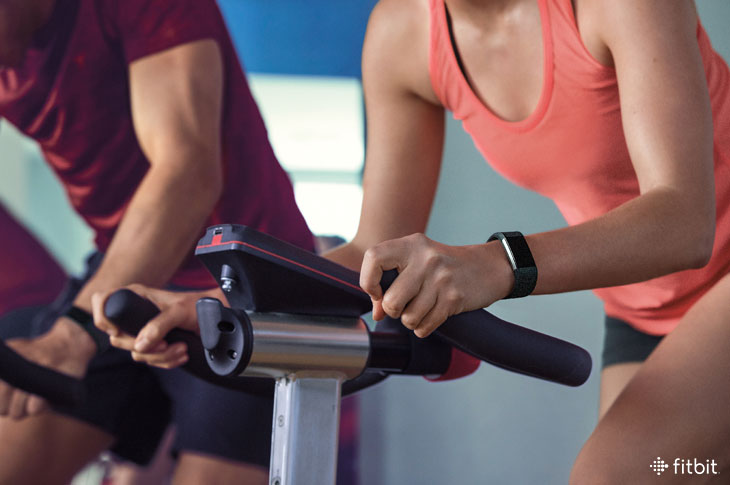
You might have heard of VO2 Max—a number that helps show your fitness level—and Fitbit’s new feature: Cardio Fitness Level, which is based on your Cardio Fitness Score: an estimate of your VO2 Max and currently available with Fitbit Blaze and Fitbit Charge 2. Even if you don’t have the latest tracker, you can still increase your VO2 Max, by improving how efficiently your body processes and uses oxygen. In plain speak: that means becoming a healthier, fitter you.
So how do you boost your VO2 Max or Cardio Fitness Score—and essentially, increase your aerobic capacity? Losing weight can help make your number go up, but one of the best ways to increase your cardiorespiratory endurance is with exercise. Research shows higher-intensity exercise via intervals (when you push yourself during a workout for short bursts of time) can give your numbers the biggest boost. Here’s how to slot intervals into five everyday workouts, so you can elevate your heart rate—and your fitness level.
If you’re walking:
Instead of taking a leisurely stroll, do as celebrity trainer and Fitbit ambassador Harley Pasternak suggests, and walk with purpose. The average 155-lb person walking at a brisk pace of 3.5 miles per hour for 30 minutes can burn roughly 150 calories. You can also elevate your heart rate. If that’s too fast for you, practice boosting your speed with intervals. Push your pace for one minute, and then dial it back to a more leisurely walk for the next minute. Alternate ten times.
You can also head for the hills, as a brisk hike can elevate your heart rate even more.
If you’re running:
Play with your speed. The Swedish (and common fitness) term for speed play is Fartlek, which means shifting your speed and intensity at slightly random intervals during your run. Challenging yourself more during exercise allows your heart rate to rise without breaking your energy bank. The fun part about fartleks (aside from their wacky name) is that you can vary them—perhaps running hard for 30 seconds, or to a tree you spot down the road—for one interval, with a minute of walking in between, and then pushing for 45 seconds during the next interval, with two minutes of walking or jogging in between.
If you’re strength training:
Perform circuits that engage various muscle groups to keep your heart rate elevated. For example, after a set of push-ups, do a set of bodyweight squats, followed by bench dips, followed by walking lunges. Alternating exercises that work different muscles allows you to rest the one’s you’ve just worked while you continue to move. Repeat your entire circuit three times, resting for 30 seconds to a minute (perhaps for a water break) in between each entire series if you need.
Another way to rev your ticker in the weight room is to perform short sets with heavier weights. High-intensity strength training can boost your heart rate, too.
If you’re doing yoga:
Look for a Vinyasa, Power, or “Flow” class. You’ll consistently move with your breath, which helps keep your heart rate elevated. If you can’t find a flow class, try holding Warrior 2 for as long as you can. According to Power Yoga teacher Rudy Mettia, the pose creates a full-body, heart-revving challenge.
If you’re cycling (outside or in!):
Try Fitbit ambassador and cycling legend Jens Voigt’s 40/20 intervals, to keep your rides quick and interesting—whether you’re out on the road or on a stationary bike. Pedal for 40 seconds with a cadence of 80 and as much resistance as you can tolerate, followed by 20 seconds with a 100-stroke cadence, and no resistance. Repeat 10 times.
The burst with resistance will add an extra challenge, and push you into your anaerobic threshold—which is when your body starts to produce lactic acid faster than it can clear it. In other words, it means you’re working hard.
The new Cardio Fitness Level feature allows you to see a snapshot of your fitness level using a personalized Cardio Fitness Score —an estimate of your VO2 Max—in the Fitbit app. The feature makes VO2 Max, a measurement typically determined in a lab and reserved for elite athletes, available to you—in a much more approachable way. Now you can see how your workouts and daily steps impact your cardiovascular fitness. Cardio Fitness Level is currently exclusive to Fitbit Charge 2.
This information is for educational purposes only and is not intended as a substitute for medical diagnosis or treatment. You should not use this information to diagnose or treat a health problem or condition. Always check with your doctor before changing your diet, altering your sleep habits, taking supplements, or starting a new fitness routine.

Can I transfer my swimming to my fiitbit 2 at all . I do 40 lengths in 35 mins , and it seem a shame i can’t put it down has my exercise . Just wondered .
I appreciate the tips.
I bought the FitBit HR because of the lawsuit off the fit but being inaccurate how can I know for sure what’s true and what’s not I am wearing to fit bit zip on my shoe and the HR of our wrist. Still not sure if truly accurate or not including pulse rate
Hi Terri. Fitbit is dedicated to developing the most consistently accurate wrist-based activity trackers on the market. We are constantly working to provide customers with the best experience possible by releasing new features and updates to improve our products, including features like heart rate. For tips and info on heart rate, check out this Fitbit help article. If you need any more help, please reach out to us via our other support channels and we’d be happy to assist!
How do I track my cycling workout with my Fit Bit HR?
Sometimes I question the validity of the Fitness cardio fitness score. For example, my score went from the low 40’s to low 50’s within 2-3 months after getting this feature. It said my fitness score was excellent for a person of my age, which is 61. Then, one day, the fitness score dropped down to the mid 30’s.
My daily routine is to do a minimum of 10 miles walking, mostly at high intensity. Sometimes I run, but very little. I walk at a pace around 12-14 minutes per mile. My weight has dropped almost 50 pounds since mid March and currently under the recommended BMI of 25 at 24.6. My resting pulse rate is very good, usually in the high 40’s or very low 50’s for the last 2 months. BP is completely normal (currently around 115/65) after experiencing pre-hypertension (145/79) prior to restarting my fitness routine in February.
I watch what I eat, log my meals, check my BP daily, and always under my calorie goals. Usually lose anywhere from 1-4 pounds a week, lately been closer to the 1-2 pounds per week.
Maybe I’m missing something but I would think my routine would be improving my fitness, not degrading it. But going the other way after going up initially, gives me the impression that my high intensity walking is not sufficient.
I found exercising boring, then I discovered hiking in the hills where we live. I was taking a camera but that interfered with my keeping moving, but after a while I took fewer pictures. As I lost weight it certainly became easier to go up steep trails and I realized carrying more gear would make up for that. Now, at about 140#, after two hours of hiking I take off the 26# of gear and there is some definite spring in my steps. I’ve noticed on my hiking as I transition from a moderate climb to a steep climb my heart rate on the monitor goes from just below 150 to about 115 or so. Last year it would be around 170, with the loss of mass in the wrist area I wonder if that makes it more difficult for the photometric measurements?
hi im barry scott